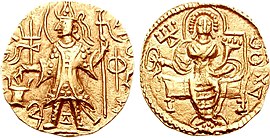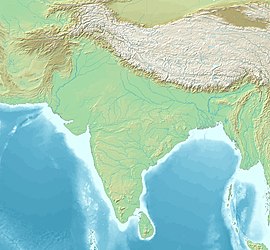바시스카
Vāsishka| 바시스카 | |
|---|---|
| 쿠샨 천황 | |
 바시슈카의 코네이지 Cerca 240–250 CE. 옵버스 : [þaonanoþAo Bazh]þKO K[O]þA[NO] (Shaonanoshao Bazishko Koshano) in Greco-Bactrian script, Vasishka, nimbate, diademed, and crowned, standing facing, head left, sacrificing over an altar to left, and holding trident in left hand; filleted trident to left; "Vira" in Brahmi script to inner left at feet; "Va" in Brahmi between legs; "Chu" 역: 그레코-박트리아 문자의 ΔXOO, 왕좌에 마주앉은 nimbate와 diademed Ardoxsho, 오른 손에 오려낸 가구를 들고 왼팔에 코르누코피아를 안고 있는 발, 위에서 왼쪽으로 탐하.[1] | |
| 군림하다 | CE 247–265년 |
| 전임자 | 카니슈카 2세 |
| 후계자 | 카니슈카 3세 |
| 쿠산 제국 CE-350 CE 30 | ||||||||||||||||||||||||||||||
|---|---|---|---|---|---|---|---|---|---|---|---|---|---|---|---|---|---|---|---|---|---|---|---|---|---|---|---|---|---|---|
| ||||||||||||||||||||||||||||||
Vāsishka (Bactrian: BAZHÞKO Bazēško; Middle Brahmi ![]()
![]()
![]() Vā-si-ṣka, Vāsiṣka; Kharosthi: 𐨬𐨗𐨿𐨱𐨅𐨮𐨿𐨐 Va-jhe-ṣka, Vajheṣka;[3] ruled c. 247–265 CE) was a Kushan emperor, who seems to have had a short reign following Kanishka II.
Vā-si-ṣka, Vāsiṣka; Kharosthi: 𐨬𐨗𐨿𐨱𐨅𐨮𐨿𐨐 Va-jhe-ṣka, Vajheṣka;[3] ruled c. 247–265 CE) was a Kushan emperor, who seems to have had a short reign following Kanishka II.
규칙
펀자브 지역의 바시스카 지배는 마투라(이사푸르 비문) 영역뿐만 아니라 [4]비문으로도 증명된다.[5] 그의 통치는 남쪽 멀리 산치까지 기록되어 있는데, 산치에는 22년("바스크후사나"-e.e)의 산치 비문이 하나, 아마도 다른 비문이 발견되었을 것이다. 바시시카 쿠샤나)와 28년(바사스카이의 산치 비문. 쿠샨 시대의 바시쉬카) (전반적으로 카니슈카 시대의 2세기로 생각된다. 이로써 그의 치세는 247–265가 될 것이다.
비문 및 명기
바시쉬카는 인더스 지역에 있는 카로슈티 비문을 포함하여 네 개의 알려진 비문에 등장한다.[4]
산치보살라바
산치 유적에서는 바시슈카라는 이름을 가진 마투라 미술의 조각상이나 조각상이 여러 점 발견되었다.[6] 그 중 하나는 "바시시카 28년"으로 추정되는 보살 좌상이다. 비문에는 다음과 같이 적혀 있다.[7]
L.1 ........... sya [r]j[i] r [a]jasya Dēvaputrasya sh[a]hi V[a][s]shkasya sa[ṁ] 20 8 hi I di I di 5 as ya purv [a] bhaga[va]
L.2 sya jambuchaha-ya-jailagi [ha]sya Dharmadvava viharē pratishṭita Virasya dhitare Madhuriaka.
L.3 [Anē]na deyadharma-pari [tygena]
"Success : In the year 28 of Mahārāja Rājatirāja Devaputra Shāhi Vāsishka, in the first month of winter, on the fifth day, on this date, Madhurika, daughter of Vīra, installed (an image) of Bhagavat (Bodhisattva) sitting on the hill under the shade of the Jambu (rose-apple) tree in the Dharmadāvavihāra.
이 선물에 의해.... " [7]
산치대좌
산치에서 발견된 또 다른 마투라 파편으로는 입상 불상의 받침대가 있다.[6] 비문에는 "바시스카 쿠샤나 22년"이라고 새겨져 있는데, 이것은 "바시카 쿠샤나"일 가능성이 있다.[8][9] 쿠샨 양식의 전형적인 벨트를 매고 긴 튜니컬을 입은 신도들이 앉아 있는 보드보살 주위에 서 있는 것을 볼 수 있다.[7] 비문에는 다음과 같이 적혀 있다.
L.1 ..... 라즈뇨 바스쿠샤샤샤샤 사 20 2 va 2 di 10 Bhagavato Sakkyam[un]eḥ pratima Pratima Pratisha Vidyamiye pu.
L.2 ......마타피티시우타 사르바사타바나카 히타수
"바스쿠샤아왕(재위) 22년, 우기 2개월째인 10일, (이) 바스쿠샤아티 석가모니의 이미지는 ......, 그리고 (그녀의) 부모와 모든 생물의 복지와 행복을 위해 비디야마티가 설치했다."[10]
아라 비문
바시쉬카는 아톡 남쪽이 아닌 인더스 지방에서 발견된 카니슈카 3세의 '아라 비문'에 등장한다. 이 비문에는 카니슈카 3세로 추정되는 카니슈카의 아버지로 제시되어 있으며, 그의 이름은 하로슈티에 "바제슈카"[2]로 나타나 있다.
이사푸르 비문, 24년
An inscription in the name of Vasishka in pure Sanskrit in Middle Brahmi script, with his full imperial titles Mahārājasya rājātirājāsya devaputrasya Shāhe Vvāsishkasya ("Of the Great King, the King of kings, His Majesty, Shahi Vasishka") was found in Isapur (27°30′41″N 77°41′21″E / 27.5115°N 77.6893°E/ ), 마투라 시 근처, 지금 마투라 박물관에 있는 희생제 브라흐마니컬 기둥인 "유파"의 축 위에 있다.[12][13]
코네이지
바시쉬카의 동전은 그의 전임자들보다 작아져서 점점 더 작은 플랜트에 채굴되었고, 금속의 질은 저하되었다.[4] 그의 동전의 뒷면에 등장하는 신들은 후비슈카나 바수데바 1세의 동전에 나오는 신들과 비슷하다.[4]
바시스카의 동전 몇 개가 쿠샤노-사사시아누스 통치자 아르다시르 1세의 동전들과 함께 발견되어 두 통치자 사이의 경쟁과 상호작용의 수준을 암시하고 있다.[14]
바시쉬카의 동전은 보통 그레코-박트리아 문자 þAONANOþAO BAZIþKO KOþANO "쿠샤노왕의 왕"에 나오는 전설을 가지고 있다.[15]
이름이 약간 다른 몇몇 동전들(반대 전설 aAONANOaAO BAZOΔηO/BOZOPHO KOþANO "쿠샨 바조도왕의 왕")은 일반적으로 바시시카 본인과 동일시되는 "바스코샤나"로 귀속되었다.[16][17]
참조
- 2005년 S. R. Goyal, "Ancient Indian Bright"
- "페르세폴리스에서 펀자브까지: '고대 이란, 아프가니스탄, 파키스탄 탐험' 엘리자베스 에링턴과 베스타 사르코시 커티스, 2007.
- 아시아의 교차로: 이미지 및 심볼의 변형" 엘리자베스 에링턴과 조 크립브, 1992년.
참조
- ^ CNG 코인 공지
- ^ a b Rosenfield, John M. (1967). The Dynastic Arts of the Kushans. University of California Press. p. 57.
- ^ 코노우, 스텐, 카로슈흐 비문(Aśoka, Corpus Brightum Indicarum, Vol)을 제외한 비문(Vol II, 1부. 캘커타: 인도 중앙 출판부, 페이지 163
- ^ a b c d Rezakhani, Khodadad (2017). From the Kushans to the Western Turks. p. 203.
- ^ Rosenfield, John M. (1967). The Dynastic Arts of the Kushans. University of California Press. p. 57.
- ^ a b Mitra, Debala (2001). Sanchi. Archeological Survey of India. p. 7 Note 1.
- ^ a b c Kuraishi, Mohammad Hamid; Kak, Ram Chandra; Chanda, Ramaprasad; Marshall, John Hubert (1922). Catalogue of the Museum of Archaeology at Sanchi, Bhopal State. Calcutta, Superintendent Government Printing, India. pp. 29–32.
- ^ Dani, A. H.; Staff, UNESCO; Asimov, M. S.; Litvinsky, B. A.; Zhang, Guang-da; Samghabadi, R. Shabani; Bosworth, C. E. (1994). History of Civilizations of Central Asia: The Development of Sedentary and Nomadic Civilizations, 700 B. C. to A. UNESCO. p. 253. ISBN 9789231028465.
- ^ "22년 산치 기록의 바스카우샤나(=바시시카 쿠샤나?)와 동일시할 수 있다면 2년이라도 일찍 통치를 시작했을지도 모른다."
- ^ Marshall, Sir John (1902). Monuments Of Sanchi Vol.1. p. 386.
- ^ Konow, Sten (1929). Kharoshthi Inscriptions With The Exception Of Those Of Asoka. p. 163.
- ^ Catalogue Of The Archaeological Museum At Mathura. 1910. p. 189.
- ^ Rosenfield, John M. (1967). The Dynastic Arts of the Kushans. University of California Press. p. 57.
- ^ Rezakhani, Khodadad (2017). ReOrienting the Sasanians: East Iran in Late Antiquity. Edinburgh University Press. p. 134. ISBN 9781474400312.
- ^ Singh, Arvind Kumar (1996). Coins of the Great Kushanas. Parimal Publications. p. 23.
- ^ Friedberg, Arthur L.; Friedberg, Ira S.; Friedberg, Robert (2017). Gold Coins of the World - 9th edition: From Ancient Times to the Present. An Illustrated Standard Catlaog with Valuations. Coin & Currency Institute. p. 474, coin 38-39. ISBN 9780871840097.
- ^ 바반, 바라트 Kala. 샤르마, Savita(1999년)에"그 동전은 전설 'ShaonanoShao Ba-Zodeo/Bozoeo Koshano의 베어링,('PAONANOPAO BA-ZOAHO/BOZOHO KOPANO의)1시쯤 46Vaskushana(Vasishka)Gobl에 의해에 기인하였던 시작한다.".골드 동전 제국 Kushāṇas과 그들의 Successors의 바라트 Kala 바반에서.바라트 Kala 바반, 바나라스. 힌두교 대학. p.는 51세입니다.
외부 링크
| ||||||||||||||||||||||||||||||||||||||||||||||||||||||||||||||||||||||||||||||||||||||||||||||||||||||||||||||||||||||||||||||||||||||||||||||||||||||||||||||||||||||||||||||||
- ^ 루카나 사리갖춤에 새겨진 옛 글로부터
- ^ Richard Salomon (July–September 1996). "An Inscribed Silver Buddhist Reliquary of the Time of King Kharaosta and Prince Indravarman". Journal of the American Oriental Society. 116 (3): 418–452 [442]. JSTOR 605147.
- ^ Richard Salomon (1995) [Published online: 9 Aug 2010]. "A Kharosthī Reliquary Inscription of the Time of the Apraca Prince Visnuvarma". South Asian Studies. 11 (1): 27–32. doi:10.1080/02666030.1995.9628492.
- ^ a b c d e f g h i j k l m Jongeward, David; Cribb, Joe (2014). Kushan, Kushano-Sasanian, and Kidarite Coins A Catalogue of Coins From the American Numismatic Society by David Jongeward and Joe Cribb with Peter Donovan. p. 4.














